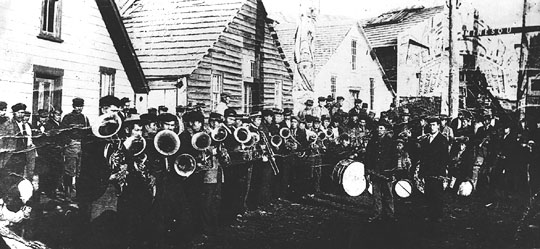VABBS
HomeAbout VABBS
Members
Events
News Archive
What is a Brass Band?
Research Project: History of Brass Bands in BC
Links
Little Mountain Brass BandBrass Belles
Other Links
Contacts
Brian StrideJim Littleford
Web Administrator
Research Project: History of Brass Bands in British Columbia
Aiyansh
Credits
Much of the information in this article is summarized from the following publications:
The Aiyansh Band was formed in 1887. In 1890 William White came from Port Simpson to become musical director of the band. In about 1891 the band trainer, composer and teacher Job Nelson was brought from New Metlakatla as instructor, but it appears that Isaac Wright was the local bandmaster, assisted by Michael Bright. For several winters in the latter part of the nineteenth century, the natives would escort Nelson by canoe from New Metlakatla on Annette Island to Aiyansh, where he would spend the winter months.
The band appears to have had different names over the course of its history, including the Aiyansh Brass Band and the Kitlakdamik Harmonic Silver Band.
In 1893 the Reverend J. B. McCullach, an Anglican missionary, took over management of the group and renamed it the Aiyansh Harmonic Silver Band. McCullach ordered new instruments from England, and turned the ensemble into a "gospel" band.
The Band’s first major journey outside the Nass Valley was made in 1905 when they attended the Dominion Exhibition in New Westminster.
The following were important instructors for the Aiyansh Band: R. Guffman (1910), William J. Mercer (1917-24), Benjamin Monroe (1924-53), Henry P. McMillan (1953-57, 1959) and Ernie Morven (c. 1960-75).
The group has always been one of the largest of the Nass River bands, and the evidence of old photographs shows its growth from 22 pieces in 1946 to 50 pieces in 1959. The instrumentation of the group in 1959, in addition to the normal complement of brasses and woodwinds, included alto clarinet, piccolo, bass clarinet, oboe and soprano saxophone. In 1965 a junior band was begun, which was integrated into the local school system in 1979.

Gitlaxdamsk Brass Band, ca. 1910. Photographer C.M. Barbeau.
Author: Brian Stride (2012)
Return to First Nations Brass BandsUpdated 2012 Feb 24, 23:56 EST/EDT


